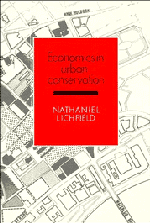Book contents
- Frontmatter
- Contents
- List of diagrams, tables and plans
- Preface
- Acknowledgements
- Introduction
- Part I Planning and management in the conservation of the urban system
- 1 Life cycle in the urban system
- 2 Planning and management of urban resources
- 3 Planning for urban conservation
- Part II Conservation of the cultural built heritage
- Part III Economics in urban conservation
- Part IV Selected tools of economic analysis for project evaluation
- Part V Case studies in the economics of conservation of the CBH
- Notes
- Bibliography
- Index
3 - Planning for urban conservation
Published online by Cambridge University Press: 10 November 2010
- Frontmatter
- Contents
- List of diagrams, tables and plans
- Preface
- Acknowledgements
- Introduction
- Part I Planning and management in the conservation of the urban system
- 1 Life cycle in the urban system
- 2 Planning and management of urban resources
- 3 Planning for urban conservation
- Part II Conservation of the cultural built heritage
- Part III Economics in urban conservation
- Part IV Selected tools of economic analysis for project evaluation
- Part V Case studies in the economics of conservation of the CBH
- Notes
- Bibliography
- Index
Summary
Role of planning in the evolution of the urban and regional system
The general planning process
The urban and regional system of cities, towns and villages has evolved over the centuries under the stimulus of forces within which the private or public sector entrepreneurs and land owners take their decisions (1.1). In simple terms, these are the ‘market forces’ of the interplay of supply and demand.
For most of these centuries, and in most communities, there has been some constraint over the ‘market’ through governmental control. For example, those rebuilding in the City of London after the Great Fire of 1666 needed licences. But it is only over the current century that government generally and internationally has taken the view that the evolution of their urban and regional systems under the impact of ‘market’ forces can lead to future situations in town and countryside which are not desirable in terms of community goals and objectives. Accordingly they have introduced urban and regional planning, known also by a variety of synonyms: town, town and country, spatial, physical, community. In doing so government has recognised that such a planning can have little effect in practice in any particular country unless it is introduced as a governmental function, with its own system of laws, administrative machinery, institutions, financial adjustments between affected owners and the state, and qualified manpower. The function typically embraces plan making, plan implementation and plan review. The generic process varies from country to country, and time to time. In the following is described a typical, mature process, based on the British planning system, in which can be seen the planning and implementation model described above (2.5).
- Type
- Chapter
- Information
- Economics in Urban Conservation , pp. 50 - 58Publisher: Cambridge University PressPrint publication year: 1989



